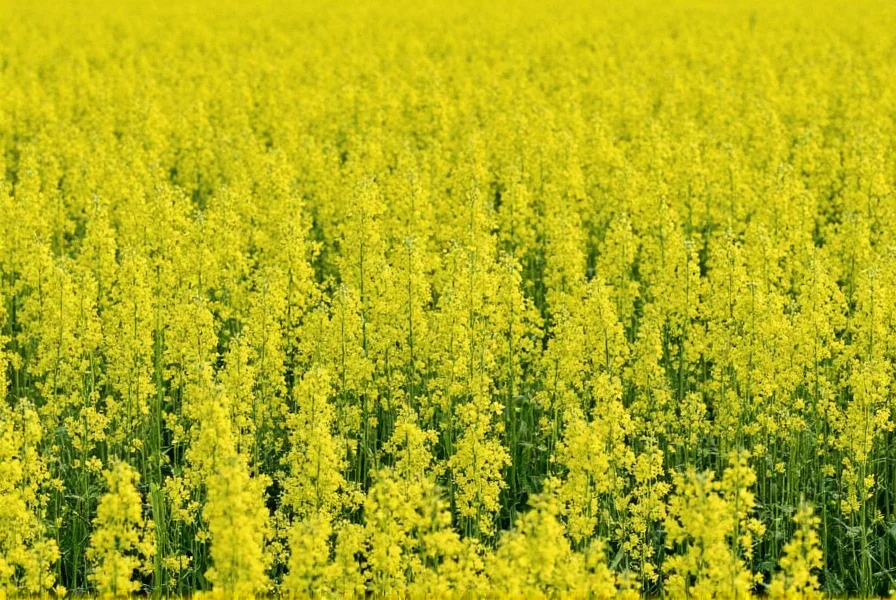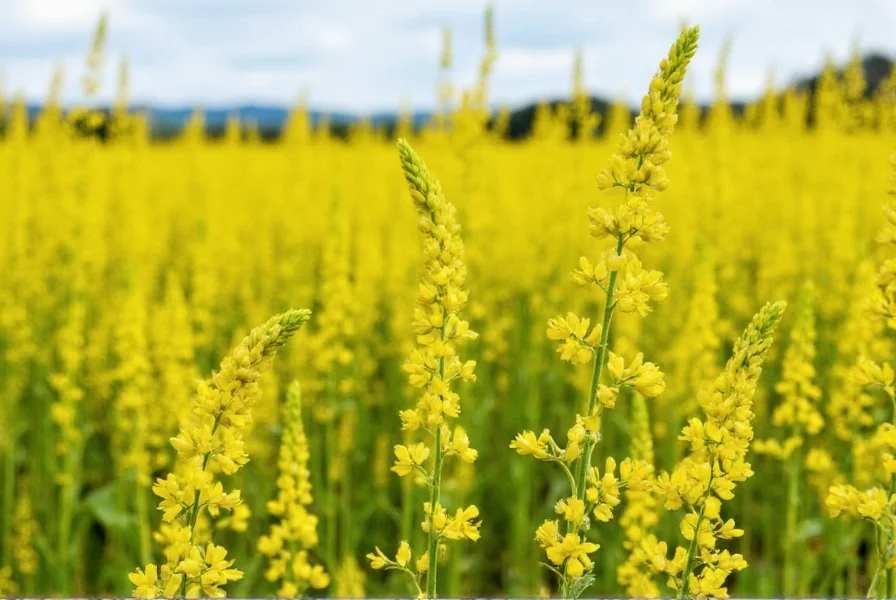Mustard cultivation represents one of the world's most adaptable agricultural practices, with historical roots tracing back to ancient civilizations. Modern farming techniques have refined mustard crop production while maintaining its fundamental growing requirements. This comprehensive guide explores evidence-based practices for successful mustard cultivation across diverse agricultural settings.
Understanding Mustard Crop Varieties
Three primary species form the foundation of commercial mustard production:
| Variety | Scientific Name | Germination Temp | Primary Uses |
|---|---|---|---|
| Yellow/White | Sinapis alba | 40-95°F (4-35°C) | Condiments, oil production |
| Brown | Brassica juncea | 45-85°F (7-29°C) | Spicy mustards, leafy greens |
| Black | Brassica nigra | 45-80°F (7-27°C) | Specialty condiments, cover cropping |
Yellow mustard accounts for approximately 75% of global production due to its disease resistance and mechanical harvesting compatibility. Brown mustard varieties like 'Oriental' and 'Florida Broadleaf' have gained popularity among organic growers for their dual-purpose potential as both seed and leaf crops. Black mustard, though less commercially dominant, offers unique flavor compounds valued in artisanal food production.
Optimal Growing Conditions for Mustard Crops
Successful mustard cultivation depends on precise environmental management. These cool-season crops perform best with daytime temperatures between 60-70°F (15-21°C) and nighttime temperatures of 40-50°F (4-10°C). Temperatures exceeding 80°F (27°C) during flowering significantly reduce seed set and increase premature bolting.
Soil preparation represents a critical success factor for mustard crop production. The ideal soil profile features:
- Loamy texture with 2-3% organic matter content
- pH between 6.0-7.5 (yellow mustard tolerates slightly higher pH than brown varieties)
- Adequate drainage to prevent waterlogging during germination
- Pre-plant soil test revealing 80-120 lbs/acre available nitrogen
Research from agricultural extension services demonstrates that mustard crops grown in soils with proper nutrient balance produce 15-20% higher yields with improved seed quality. Incorporating 2-3 tons/acre of well-composted organic matter four weeks before planting enhances soil structure and nutrient availability for optimal mustard crop development.
Planting Techniques and Crop Management
Timing your mustard crop planting according to regional climate patterns proves essential for maximizing yield potential. In temperate zones, spring planting should occur 2-4 weeks before the last frost date when soil temperatures reach 40°F (4°C). Fall planting for overwintering varieties works best 6-8 weeks before first frost.
Seed placement directly impacts establishment success:
- Plant seeds at ¼ to ½ inch depth in heavy soils
- Adjust to ¾ inch depth in sandy soils
- Maintain 6-8 seeds per foot in rows 12-18 inches apart
- Thin seedlings to 4-6 inches between plants at 2-3 leaf stage
Irrigation management requires particular attention during critical growth stages. Mustard crops need consistent moisture during germination and flowering but become moderately drought-tolerant during seed fill. Implement drip irrigation or furrow systems to deliver 1-1.5 inches of water weekly during establishment, reducing to 0.5 inches weekly during maturation. Overhead irrigation during flowering increases disease pressure and should be avoided.
Pest and Disease Management Strategies
Mustard crops face several common biological challenges requiring integrated management approaches. Flea beetles represent the most significant insect pest, particularly during seedling stages. Research indicates that planting resistant varieties like 'Cutlass' or 'Canau' reduces damage by 40-60% compared to standard varieties.
Effective disease prevention protocols include:
- Implementing 3-4 year crop rotation with non-brassica species
- Using certified disease-free seed to prevent blackleg introduction
- Maintaining proper field drainage to minimize white mold development
- Applying sulfur-based fungicides at first sign of alternaria leaf spot
Organic growers have found success with companion planting mustard crops alongside aromatic herbs like rosemary and thyme, which naturally repel aphids and cabbage loopers. Recent field trials demonstrate that intercropping with clover reduces pest pressure by 25% while improving soil nitrogen levels for subsequent mustard crop rotations.

Harvesting and Post-Harvest Processing
Timing the harvest correctly determines final seed quality and yield. Mustard crops reach physiological maturity when 60-70% of pods turn tan and seeds inside rattle when shaken. Swathing typically occurs at 35-40% seed moisture content, with direct combining possible at 8-10% moisture.
Proper drying and storage protocols prevent quality degradation:
- Air-dry seeds to 8-9% moisture before long-term storage
- Store in ventilated containers at 50-60°F (10-15°C)
- Maintain relative humidity below 65% to prevent mold growth
- Check stored seeds monthly for temperature spikes indicating spoilage
Commercial growers achieve premium prices by maintaining seed purity through careful equipment cleaning between varieties. Research shows that even 0.5% cross-contamination between yellow and brown mustard varieties can reduce market value by 15-20% in specialty markets.
Economic and Environmental Benefits
Mustard crops deliver significant economic value while supporting sustainable farming practices. Global mustard seed production exceeds 9 million metric tons annually, with Canada, Nepal, and Russia leading production. The average farm gate price ranges from $0.20-$0.35 per pound, depending on variety and quality specifications.
Environmental benefits make mustard crops valuable in integrated farming systems:
- Allyl isothiocyanates in mustard roots suppress soil-borne pathogens
- Deep taproots break up soil compaction in rotation systems
- Nitrogen scavenging reduces fertilizer requirements for subsequent crops
- Flowering periods provide critical early-season pollinator habitat
Recent agricultural studies confirm that incorporating mustard crops into rotation sequences reduces synthetic pesticide use by 20-30% while maintaining or increasing overall system productivity. This makes mustard cultivation particularly valuable for farmers transitioning to more sustainable production methods.
Troubleshooting Common Mustard Crop Challenges
Even experienced growers encounter challenges with mustard crops. Understanding these issues and their solutions proves essential for consistent production:
- Uneven germination: Caused by inconsistent soil moisture or temperature fluctuations. Solution: Use precision planters with depth control and implement consistent irrigation during establishment.
- Pod shatter: Occurs when harvesting is delayed past optimal maturity. Solution: Harvest at 35-40% seed moisture content and avoid field operations during dry, windy conditions.
- Nutrient deficiencies: Yellowing leaves indicate nitrogen deficiency; purple discoloration suggests phosphorus shortage. Solution: Conduct regular tissue testing and apply targeted foliar nutrients as needed.
- Wind damage: Tall mustard varieties may lodge in high winds. Solution: Plant windbreaks or select shorter-statured varieties like 'Rainbow' for exposed locations.
Frequently Asked Questions
How long does it take for mustard crops to mature from planting to harvest?
Most mustard varieties require 80-120 days from planting to harvest, depending on the specific variety and growing conditions. Yellow mustard typically matures in 90-100 days, while brown and black varieties may take 100-120 days. Cool temperatures can extend the growing period by 10-15 days.
What are the best preceding crops for mustard in rotation systems?
Grain crops like wheat, barley, or oats make excellent preceding crops for mustard cultivation. Avoid planting mustard after other brassica crops (canola, broccoli, cabbage) due to shared disease and pest vulnerabilities. A minimum 3-4 year rotation interval between brassica crops prevents disease buildup and maintains soil health.
Can mustard crops be grown successfully in organic farming systems?
Yes, mustard crops adapt well to organic production systems. Organic growers should focus on soil health through compost applications, implement diverse crop rotations, and use resistant varieties. Mustard's natural biofumigant properties help control soil pathogens, reducing the need for external inputs. Certified organic mustard typically commands a 20-30% price premium in specialty markets.
What soil pH range is optimal for growing mustard crops?
Mustard crops perform best in slightly acidic to neutral soils with a pH between 6.0 and 7.5. Yellow mustard tolerates slightly higher pH levels (up to 8.0) better than brown or black varieties. Soil pH outside this range can cause nutrient deficiencies, particularly in iron and manganese, leading to reduced yields and poor seed quality.











 浙公网安备
33010002000092号
浙公网安备
33010002000092号 浙B2-20120091-4
浙B2-20120091-4